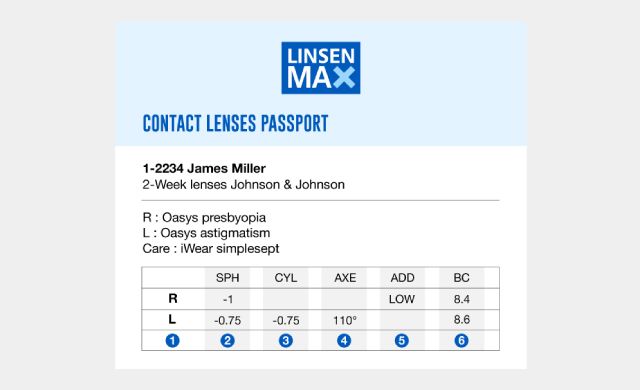If you're reading this article, you've probably just received your first contact lens prescription and you may feel a little lost. Don't worry, that's perfectly normal! Contact lens prescriptions can seem complicated at first, but once you understand the different terms and numbers, it's easy to know which lenses to choose for your eyes.
The important information in your prescription
Let's start at the beginning: the contact lens prescription contains several important pieces of information, including lens power, base curve, lens diameter and lens brand. Lens power is probably the most important piece of information on your prescription. It is measured in dioptres (D) and indicates how myopic (difficulty seeing at a distance), hyperopic (difficulty seeing at a distance), or astigmatic (blurred vision in all directions) your eyes are.
-
If you are short-sighted, the power of your lenses is negative (-). The higher the power, the more myopic you are, which means you have difficulty seeing things far away.
-
If you are farsighted, your lens power is positive (+). The higher the power, the more farsighted you are, which means you have difficulty seeing things up close.
-
If you have astigmatism, your lens power will also be positive or negative, but with a different number to indicate the direction of the astigmatism.
The meaning of the letters on your prescription


-
To indicate your left eye: L
-
To indicate your right eye: R
-
For the correction sphere, power or diopter: SPH (from -20.00 to +20.00).
-
When the power is negative (-), the sphere corrects myopia.
-
When the power is positive (+), the sphere corrects hyperopia.
-
-
CYL: cylinder of the lens (in dioptres). The cylinder corrects an astigmatism.
-
AXIS: axis of the lens (from 0° to 180°). The axis corrects an astigmatism.
-
ADD: addition (in dioptres). The addition corrects presbyopia.
-
BC: Base curve/radius (from 8.0 to 10.0) This is the radius of curvature of the lens.
The brand of the lenses
Your contact lens prescription will also tell you which brand of lenses your optician recommends. There are many lens brands on the market, each with its own characteristics and benefits. Follow your optician's recommendations to get the best results from your lenses.
Which contact lenses to choose?
Now that you understand the different terms and numbers on your prescription, you can choose the contact lenses that are best for your eyes. There are different types of lenses, including soft lenses, rigid lenses and disposable lenses.
Soft lenses are the most common and are ideal for people with a mild to moderate prescription. They are comfortable to wear and can be worn for long periods of time.
Rigid lenses, also known as gas permeable lenses, are stronger than soft lenses and can provide better vision for people with more severe corrections. They are more resistant to deposits and can be worn for longer periods of time.
Daily disposable lenses are designed to be worn for a short period of time and disposed of after each use. They are ideal for people with allergies or sensitive eyes.
Contact lens prescriptions can seem daunting at first, but once you understand the different terms and numbers, you can easily choose the lenses that are best for your eyes. Follow your optician's recommendations for lens care to ensure clear, comfortable vision all day long. If you have any questions or concerns, don't hesitate to ask your optician for further advice.
And remember, with a little practice and patience, you can easily understand your contact lens prescription and enjoy clear vision!





